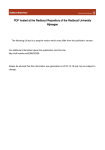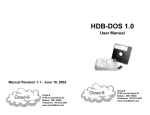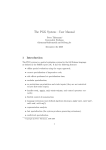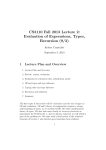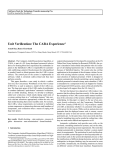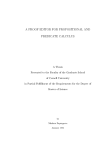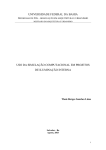Download Extensible Hierarchical Tactic Construction in a Logical Framework *
Transcript
Extensible Hierarchical Tactic Construction in a
Logical Framework ?
Jason Hickey and Aleksey Nogin
Department of Computer Science, California Institute of Technology
M/C 256-80, Pasadena, CA 91125
{jyh,nogin}@cs.caltech.edu
Abstract. Theorem provers for higher-order logics often use tactics to
implement automated proof search. Often some basic tactics are designed
to behave very differently in different contexts. Even in a prover that only
supports a fixed base logic, such tactics may need to be updated dynamically as new definitions and theorems are added. In a logical framework
with multiple (perhaps conflicting) logics, this has the added complexity
that definitions and theorems should only be used for automation only
in the logic in which they are defined or proved.
This paper describes a very general and flexible mechanism for extensible
hierarchical tactic maintenance in a logical framework. We also explain
how this reflective mechanism can be implemented efficiently while requiring little effort from its users.
The approaches presented in this paper form the core of the tactic construction methodology in the MetaPRL theorem prover, where they have
been developed and successfully used for several years.
1
Introduction
Several provers [1,2,4,5,6,9,10,18] use higher-order logics for reasoning because
the expressivity of the logics permits concise problem descriptions, and because
meta-principles that characterize entire classes of problems can be proved and
re-used on multiple problem instances. In these provers, proof automation is
coded in a meta-language (often a variant of ML) as tactics.
It can be very useful for some basic tactics to be designed and/or expected
to behave very differently in different contexts. One of the best examples of such
a tactic is the decomposition tactic [14, Section 3.3] present in the NuPRL [1,4]
and MetaPRL [9,13] theorem provers. When applied to the conclusion of a goal
sequent, it will try to decompose the conclusion into simpler ones, normally
by using an appropriate introduction rule. When applied to a hypothesis, the
decomposition tactic would try to break the hypothesis into simpler ones, usually
by applying an appropriate elimination rule.
?
This work was supported in part by the DoD Multidisciplinary University Research
Initiative (MURI) program administered by the Office of Naval Research (ONR)
under Grant N00014-01-1-0765, the Defense Advanced Research Projects Agency
(DARPA), the United States Air Force, the Lee Center, and by NSF Grant CCR
0204193.
Table 1. Decomposition Tactic Examples
Goal sequent
Conclusion decomposition
··· ` A ∧ B
Hypothesis decomposition · · · ; A ∧ B; · · · ` · · ·
=⇒
=⇒
=⇒
Desired subgoals
· · · ` A and · · · ` B
· · · ; A; B; · · · ` · · ·
Example 1. The desired behavior for the decomposition tactic on ∧-terms is
shown in Table 1.
Whenever a theory is extended with a new operator, the decomposition tactic
needs to be updated in order for it to know how to decompose this new operator.
More generally, whenever a new rule (including possibly a new axiom, a new
definition, a new derived rule or a new theorem) is added to a system, it is often
desirable to update some tactic (or possibly several tactics) so that it makes use
of the newly added rule. For example, if a ∧ introduction rule is added to the
system, the decomposition tactic would be updated with the information that if
the conclusion is a ∧-term, then the new introduction rule should be used.
There are a number of problems associated with such tactic updates. A very
important requirement is that performing these tactic updates must be easy and
not require much effort from end-users. Our experience with NuPRL and MetaPRL theorem provers strongly suggests that the true power of the updatable
tactics only becomes apparent when updates are performed to account for almost
all the new theorems and definitions added to the system. On the other hand,
when updates require too much effort, many users forgo maintaining the general
tactics, reverting instead to using various ad-hoc workarounds and using the
tactics updated to handle only the core theory.
Another class of problems are those of scoping. The updates must be managed
in an extensible manner — when a tactic is updated to take into account a new
theorem, all new proofs should be done using the updated tactic, but the earlier
proofs might need to still use the previous version in order not to break. If a
theorem prover allows defining and working in different logical theories, then
the tactic update mechanism needs to make sure that the updated tactic will
only attempt to use a theorem when performing proof search in the appropriate
theory. And if the prover supports inheritance between logical theories, then
the updates mechanism needs to be compositional — if a theory is composed
of several subtheories (each potentially including its own theorems), then the
tactic updates from each of the subtheories need to be composed together.
Once the tactics updates mechanism becomes simple enough to be used for
almost all new definitions, lemmas and theorems, efficiency becomes a big concern. If each new update slows the tactic down (for example, by forcing it to
try more branches in its proof search), then this approach to maintaining tactics would not scale. At a minimum, the updates related to, for example, a new
definition should not have significant impact on the performance of the tactic
when proving theorems that do not make any use of the new definition (even
when that definition is in scope).
In the MetaPRL theorem prover [9,13] we have implemented a number of
very general mechanisms that provide automatic scoping management for tactic
updates, efficient data structures for making sure that new data does not have
a significant impact on performance, and a way for the system to come up with
proper tactic updates automatically requiring only very small hints from the
user. In Sections 3, 4 and 5 we describe these mechanisms and explain how they
help in addressing all of the issues outlined above. In Section 6 we show how
some of the most commonly used MetaPRL tactics are implemented using these
general mechanisms.
2
MetaPRL
In order to better understand this paper, it is helpful to know the basic structure
of the MetaPRL theorem prover.
The core of the prover is its logical engine written in OCaml [15,20]. MetaPRL
theories are implemented as OCaml modules, with each theory having a separate
interface and implementation files containing both logical contents (definitions,
axioms, theorems, etc) as well as the traditional ML contents (including tactics). The logical theories are organized into an inheritance hierarchy [9, Section
5.1], where large logical theories are constructed by inheriting from a number
of smaller ones. The MetaPRL frontend is a CamlP4-based preprocessor that is
capable of turning the mixture of MetaPRL content and ML code into plain ML
code and passing it to OCaml compiler. Finally, MetaPRL has a user interface
that includes a proof editor.
3
Resources
We implement the process of maintaining context-sensitive tactics is automated
through a mechanism called resources. A resource is essentially a collection of
scoped pieces of data.
Example 2. The decomposition tactic of Example 1 could be implemented using
a combination of two resources — a resource collecting information on introduction rules (“intro resource”) and one collecting information on elimination rules
(“‘elim resource”). For each of the two resources, the data points that would be
passed to the resource manager for collection will each consist of a pattern (e.g.
A ∧ B) paired with the corresponding tactic (e.g. a tactic that would apply a ∧
introduction rule).
The MetaPRL resource interface provides a scoping mechanism based on
the inheritance hierarchy of logical theories. Resources are managed on a pertheorem granularity — when working on a particular proof, the resource state
reflects everything collected from the current theory up to the theorem being
proved, as well as everything inherited from the theories that are ancestors of
the current one in the logical hierarchy, given in the appropriate order.
Our implementation of the resource mechanism has two layers. The lower
layer is invisible to the user — its functions are not supposed to be called directly
by MetaPRL users; instead the appropriate calls will be inserted by the MetaPRL
frontend.
Internal Interface. The interface contains the following:
type bookmark
type (’input, ’intermediate, ’output) description =
{ empty: ’intermediate;
add: ’intermediate -> ’input -> ’intermediate;
retrieve: ’intermediate -> ’output }
val create: string -> (’input, ’intermediate, ’output) resource ->
bookmark -> ’output
val
val
val
val
improve : string -> Obj.t -> unit
bookmark : string -> unit
extends_theory : string -> unit
close_theory : string -> unit
val find : string * string -> bookmark
The create function takes a name of the resource and a function for turning
a list of collected data points (in the order that is consistent with the order in
which they were added to the appropriate theories and the inheritance hierarchy
order) of the ’input type into an appropriate result of the ’output type (usually
tactic, int -> tactic, or similar) and returns a lookup function that given a
theorem bookmark will give the value of that resource at that bookmark.
The lookup function is lazy and it caches both the ’intermediate and the
’output results. For example, if bookmark B extends from a bookmark A and
the lookup is called on bookmark B, then the lookup system will use the add
function to fold all the relevant data into the empty value and will memoize
the ’intermediate values for all the bookmarks it encounters above B in the
inheritance hierarchy (including A and B itself). Next it calls the retrieve
function to get the final data for the bookmark B, memoizes and returns the
resulting data. Next time the lookup is called on bookmark B, it will simply
return the memoized ’output data. Next time the lookup function is called on
the bookmark A, it will only call the retrieve on the memoized ’intermediate
value (and memoize the resulting ’output value as well)1 . Finally, next time the
lookup function is called on another descendant of A, the lookup function will
retrieve the ’intermediate value for A and then add the remaining data to it.
1
In case there were no new data added between A and B, then the ’output value for
B will be simply reused for A.
The improve function adds a new data entry to the named resource. Note
that the Obj.t here signifies a shortcut across the type system — the MetaPRL
frontend will add a coercion from the actual input type into an Obj.t and will
also add a type constraint on the expression being coerced to make sure that
this mechanism is still type safe.
The bookmark function adds the named bookmark to all resources (the name
here is usually a name of a theorem); extends theory tells the resource manager
that the current theory inherits from another one (and that it needs to inherit
the data for all resources); close theory tells the resource manager that it
has received all the resource data for the named theory and that all the recent
bookmark and extends theory calls belong to the given theory.
Finally, find finds the bookmark for a given theorem in a given theory.
External Interface. The next layer is essentially a user interface layer and
it consists of statements that would be recognized by the MetaPRL frontend in
MetaPRL theories. First, in the theory interface files we allow declarations of the
form
resource (input,output ) name
where resource is a MetaPRL keyword, input and output are the ML types
describing the data inputs that the resource is going to get and the resulting
output type, and name is, unsurprisingly, the name of the resource (must be
globally unique).
Whenever a resource is declared in a theory interface, the corresponding
implementation file must define the resource using the
let (input,output ) resource name = expr
construct, where expr is an ML expression on an appropriate description
type. When a resource is defined, the MetaPRL frontend will create a function
get name resource of the type bookmark -> output .
All tactics in MetaPRL have access to the “proof obligation” object, which
includes the bookmark corresponding to the scope of the current proof. By applying the appropriate get name resource function to the current bookmark, the
tactic can get access to the appropriate value of any resource. This mechanism
is purely functional — there is no imperative “context switch” when switching
from one proof to another; instead tactics in each proof have immediate access
to the local value of each resource’s ’output data.
Example 3. Once the intro and elim resources (with the tactic and int ->
tactic output types respectively) of Example 2 are defined (Section 6.4 will
describe the implementation in detail), the decomposition tactic could be implemented as simple as
let dT p n =
let bookmark = get_bookmark p in
if n = 0 then
get_intro_resource bookmark
else
get_elim_resource bookmark n
where p is the proof obligation argument and n is the index of the hypothesis to
decompose (index 0 stand for the conclusion).
To add data to a resource, a MetaPRL user only has to write (and as we will
see in Section 4 even that is usually automated away):
let resource name += expr
where expr has the appropriate input type, and the MetaPRL frontend will
translate it into an appropriate improve call.
The scoping management of the resource data is fully handled by the frontend itself, without requiring any resource-specific input from the user. Whenever a logical theory is specified as inheriting another logical theory (using the
extends Theory name statement), the frontend will include the appropriate
extends theory call. Whenever a new theorem is added to a theory, the frontend
will insert a call to bookmark. Finally, at the end of each theory, the frontend
will insert a call to close theory.
4
Reflective Resource Annotations
Even in the presence of the hierarchical resource mechanism of Section 3, writing
the appropriate let resource += code every time new definitions and theorems
are added takes some expertise and could be somewhat time consuming. On the
other hand, it also turns out that most such resource updates are rather uniform
and most of the needed information is already present in the system. If the rules
are expressed using a well-defined logical meta-language (such as the sequent
schemas language [16] used by MetaPRL), then we can use the text of the rules
as a source of information.
Example 4. Suppose a new introduction rule is added to the system and the
user wants to add it to the intro resource. Using the mechanism given in the
previous Section, this might look as 2 :
···
rule xyz1:
Γ ` xyz{a; b; c}
let resource intro += (xyz{a; b; c}, xyz1)
In the above example it is clear that the resource improvement line is pretty
redundant 3 — it does not contain anything that can not be deduced from the
rule itself. If the system would be given access both to the text of the rule
and the primitive tactic for applying the rule4 , it will have most (if not all) of
the information on how to update the decomposition tactic! By examining the
2
3
4
For clarity, we are using the pretty-printed syntax of MetaPRL terms here in place
of their ASCII representations.
The redundancy is not very big here, of course, but in more complicated examples
it can get quite big.
In the MetaPRL system, all the rules (including derived rules and theorems) are
compiled to a rewriting engine bytecode, so a tactic for applying a primitive rule
does not have direct access to the text of the rule it is applying.
text of the rule it can see what kind of term is being introduced and create an
appropriate pattern for inclusion into the resource and it is clear which tactic
should be added to the intro resource — the primitive tactic that would apply
the newly added rule.
By giving tactics access to the text of the rules we make the system a bit
more reflective — it becomes capable of using not only the meaning of the rules
in its proof search, but their syntax as well.
From the MetaPRL user’s perspective this mechanism has a form of resource
annotations. When adding a new rule, a user only has to annotate it with the
names of resources that need to be automatically improved. Users can also pass
some optional arguments to the automatic procedure in order to modify its
behavior. As a result, when a new logical object (definition, axiom, theorem,
derived rule, etc.) is added to a MetaPRL theory, the user can usually update all
relevant proof search automation by typing only a few extra symbols.
Example 5. Using the resource annotations mechanism, the code of the Example 4 above would take the form
···
rule xyz1 {| intro [] |}:
Γ ` xyz{a; b; c}
where the annotation “{| intro [] |}” specifies that the new rule has to be
added to the intro resource.
Example 6. The resource annotation for the ∧ elimination rule in MetaPRL
would be written as {| elim [ThinOption thinT] |} which specifies that the
elim resource should be improved with an entry for the ∧ term and that by default it should use the thinT tactic to thin out (weaken) the original ∧ hypothesis
after applying the elimination rule.
5
Term Table
One of the most frequent uses of resources is to construct tactics for term rewriting or rule application based on the collection of rewrites and rules in the logic.
For example, as discussed the dT tactic selects an inference rule based on the
term to be decomposed. Abstractly, the dT tactic defines a (perhaps large) set
of rules indexed by a set of terms.
In a very naive implementation, given a term to decompose, the prover would
apply each of the rules it knows about in order until one of them succeeds. This
would of course be very inefficient, taking time linear in the number of rules in
the logic. There are many other kinds of operations that have the same kind of
behavior, including syntax-directed proof search, term evaluation, and display
of terms [8] based on their syntax.
Abstractly stated, the problem is this: given a set S of (pattern, value) pairs,
and a term t, find a matching pattern and return the corresponding value. In case
there are several matches, it is useful to have a choice between several strategies:
– return the most recently added value corresponding to the “most specific”
match, or
– return the list of all the values corresponding to the “most specific” match
(most recently added first), or
– return the list of all values corresponding to the matching patterns, the ones
corresponding to “more specific” matches first.
Note that when values are collected through the resources mechanism, the “most
resent” means the “closest to the leaves of the inheritance hierarchy”. In other
words we want to get the value from the most specialized subtheory first, because
this allows specialized theories to shadow the values defined in the more generic
“core” theories.
We call this data structure a term table and we construct it by collecting
patterns in an incremental manner into a discrimination tree [3,7]. Since the
patterns we use are higher-order, we simplify them before we add them to the discrimination tree (thus allowing false positive matches). The original higher-order
patterns are compiled into the bytecode programs for the MetaPRL rewriting engine [12], which can be used to test the matches found by the discrimination tree,
killing off the false positives.
We begin the description with some definitions.
5.1
Second-Order Patterns
MetaPRL represents syntax using the term schemas [16]. Each term schema is
either an object (first-order) variable v, a second-order meta-variable ν or it has
an operator that represents the “name” of the term drawn from a countable
set, and a set of subterms that may contain bindings of various arities. The
second-order variables are used to specify term patterns and substitution for
rewriting [16].
The following table gives a few examples of term syntax, and their conventional notation. The lambda term contains a binding occurrence: the variable x
is bound in the subterm b.
Displayed form Term
λx.b
lambda{ x. b }
f (a)
apply { f; a }
x+y
sum{ x; y }
Second-order variables are used to specify term patterns and substitution
for rewriting. A second-order variable pattern has the form ν[v1 ; · · · ; vn ], which
represents an arbitrary term that may have free variables v1 , . . . , vn . The corresponding substitution has the form ν[t1 ; · · · ; tn ], which specifies the simultaneous, capture-avoiding substitution of terms t1 , . . . , tn for v1 , . . . , vn in the term
matched by ν.
Example 7. Below are a few examples illustrating our second-order pattern language. For the precise definition of the language, see [16].
– Pattern ν + ν matches the term 1 + 1, but does not match the term 1 + 2.
– The term λx.x + 1 is matched by the pattern λx.ν[x], but not by the pattern
λx.ν.
– Pattern λx.ν[x] + ν[1] matches terms λy.y + 1 and λz.2 ∗ z + 2 ∗ 1.
5.2
Simplified Patterns
Before a second-order pattern is added to a discrimination tree, we simplify it by
replacing all second-order variable instances with a “wildcard” pattern and by
re-interpreting first-order variables as matching an arbitrary first-order variable.
The language of simplified patters is the following:
p ::= _
the wildcard pattern
| operator(p1 , . . . , pn ) a pattern with n subterms
| v
stands for an arbitrary first-order variable
p ::= (i, p)
i stands for the number of binding occurrences
A matching relation can be defined on term patterns t ' p as follows. First
any term t matches the wildcard pattern t ' _. For the inductive case, the term
t = operator(t1 , . . . , tn ) matches the pattern p = operator(p1 , . . . , pn ) iff tj ' pj
for all j ∈ {1, . . . , n}. A subterm v1 , . . . , vm .t matches a subpattern (m, p) iff
t ' p.
In many cases when the term table is constructed, a term will match several
patterns. In general, the table should return the most specific match. Any nonwildcard pattern is considered more specific than the wildcard one and two
patterns with the same top-level operator and arities are compared according to
the lexicographical order of the lists of their immediate subpatterns.
5.3
Implementation
The term tables are implemented by collecting the simplified patterns into discrimination trees. Each pattern in the tree is associated with the corresponding
value, as well as with the rewriting engine bytecode that could be used to check
whether a potential match is a faithful second-order match. When adding a
new pattern to a tree, we make sure that the order of the entries in the tree is
consistent with the “more specific” relation.
As described in the beginning of this Section, our term table implementation
provides a choice of several lookup functions. In addition to choosing between
returning just the most specific match and returning all matches, the caller also
gets to choose whether to check potential matches with the rewriting engine
(which is slower, but more accurate) or not (which is faster, but may return
false positives).
In order to take advantage of the caching features of the resources mechanism, the interface for building term tables is incremental — it allows extending
the tables functionally by adding one pattern at a time. In order to make the interface easier to use, we provide a function that returns an appropriate resource
description (see Section 3) where the ’intermediate type is a term table and
only the retrieve field needs to be provided by the user.
6
Resource-Driven Tactics in MetaPRL
The resource mechanisms described in the previous sections are a big part of all
the most commonly used tactics in MetaPRL. In this Section we will describe
some of the most heavily used MetaPRL resources. The goal of this chapter,
however, is not to describe some particular MetaPRL tactics, but to give an
impression of the wide range of tactics that the resource mechanisms could be
used to implement.
Those who are interested in full details of a particular tactic implementation
may find additional information in [11].
6.1
The “n-th Hypothesis” Tactic
The “conclusion immediately follows from the n-th hypothesis” tactic (“nthHypT”)
is probably the simplest resource-based tactic in MetaPRL. It is designed to prove
sequents like Γ ; T ; ∆ ` T , Γ ; x : T ; ∆[x] ` T Type, and Γ ; x : V oid; ∆[x] `
C[x], where the conclusion of the sequent immediately follows from a hypothesis.
The nthHypT is implemented via a term table resource that maps terms to
int -> tactic. The input to the nth hyp resource is a term containing both
the hypothesis and the conclusion packed together and the output is the corresponding tactic that is supposed to be able to prove in full any goals of that
form. As in Example 3, the code of the tactic itself takes just a few lines:
let nthHypT p n =
let t = make_pair_term (get_nth_hyp p n) (get_concl p) in
lookup (get_nth_hyp_resource p) t n
where p is the current proof obligation and n is the hypothesis number (same as
in Example 3).
MetaPRL also implements the annotations for this resource — whenever a rule
is annotated with {| nth hyp |}, MetaPRL would check whether the annotated
rule has the correct form and if so, if will pair its hypothesis with its conclusion
and add the corresponding entry to the nth hyp resource.
6.2
The Auto Tactic
In addition to the decomposition tactic we have already mentioned, the generic
proof search automation tactics are among the most often used in MetaPRL. We
have two such tactics. The autoT tactic attempts to prove a goal “automatically,”
and the trivialT tactic proves goals that are “trivial.” The resource mechanism
allowed us to provide a generic implementation of these two tactics. In fact,
the implementation turns out to be surprisingly simple — all of the work in
automatic proving is implemented by the resource mechanism and in descendant
theories.
The auto resource builds collections of tactics specified by a data structure
with the following type:
type auto_info =
{ auto_name : string;
auto_tac : tactic;
auto_prec : auto_prec;
auto_type : auto_type;
}
and auto_type =
AutoTrivial
| AutoNormal
| AutoComplete
The auto name is the name used to describe the entry (for debugging purposes). The auto tac is the actual tactic to try. auto prec is used to divide the
entries into precedence levels; tactics with higher precedence are applied first.
Finally, auto type specifies how autoT and trivialT will use each particular
entry. AutoTrivial entries are the only ones used by trivialT; autoT attempts
using them before any other entries. AutoComplete will be used by autoT after
all AutoTrivial and AutoNormal entries are exhausted; it will consider an application of an AutoComplete entry to be successful only if it would be able to
completely prove all subgoals generated by it.
The onSomeHypT nthHypT (“try finding a hypothesis nthHypT would apply
to” — see Section 6.1) is an important part of the trivialT tactic and dT 0 —
the intro part of the decomposition tactic — is an important part of the autoT
tactic. As we will see in Section 6.4, parts of dT 0 are added to the AutoNormal
level of autoT and the rest — at the AutoComplete level.
6.3
Type Inference
Another very interesting example of a resource-driven approach in MetaPRL is
type inference. There are several factors that make it stand out. First, the type
inference resource is used to create a recursive function, with each data item
responsible for a specific recursive case. Second, the output type of the type
inference resource is not a tactic, but rather a helper function that can be used
in various other tactics.
The type inference resource is complicated (unfortunately), so we will start
by presenting a very simplified version of the resource. Suppose, the pair operator
and the Cartesian product type is added to a logic and we want to augment the
type inference resource. In first approximation, this would look something like
let typeinf_pair infer t =
let a, b = destruct_pair_term t in
construct_product_term (infer a) (infer b)
let resource typeinf += (ha, bi, typeinf_pair)
where the infer argument to the typeinf pair function is the type inference
function itself, allowing for the recursive call. The typeinf resource would be
implemented as a term lookup table (see Section 5) and will therefore have the
input type term and the output type inference fun -> inference fun, where
inference fun is defined as term -> term.
Once the table resource is defined, the actual type inference function can be
defined simply as follows:
let infer_type p =
let table = get_typeinf_resource p in
let rec infer t = lookup table t infer t in
infer
where p is the current proof obligation (same as in Example 3). Above, lookup
table t returns the appropriate inference fun -> inference fun function
which, given the infer itself returns the inference fun function which is then
used to infer the type of the term t.
MetaPRL currently has two different implementations of a type inference
algorithm. Both implementations are similar to the simplified one outlined above,
except the inference fun type would be more complicated.
The first implementation is used as a heuristic for inferring a type of expressions in a Martin-Löf style type theory. There the type is defined as
type typeinf_fun =
ty_var_set -> var_env -> eqnlist -> opt_eqns -> var_env -> term
-> eqnlist * opt_eqns * var_env * term
An inference function takes as arguments: a set of variables that should be
treated as constants when we use unification, a mapping from variable names
to the types these variables were declared with, a list of equations we have on
our type variables, a list of optional equations (that could be used when there is
not enough information in the main equations, but do not have to be satisfied),
a list of default values for type variables (that can be used when the equations
do not provide enough information), and a term whose type we want to infer.
It returns the updated equations, the updated optional equations, the updated
defaults and the type (possibly containing new variables). The corresponding
infer type would call the infer function and then use unification to get the
final answer.
The second implementation is used for inferring a type of expressions in an
ML-like language with a decidable type inference algorithm and it is a little
simpler than the type theory one, but is still pretty complicated.
In future we are hoping to add resource annotation (at least some partial
one) support to the type inference resources, however it is not obvious whether
we would be able to find a sufficiently general (yet simple) way of implementing
the annotations. For now the type inference resources have to be maintained by
manually adding entries to it, which is pretty complicated (even the authors of
these resources have to look up the inference fun type definitions once in a
while to remind themselves of the exact structure of the resource) Because of
such complexity this solution is not yet fully satisfactory.
6.4
Decomposition Tactic
As we have mentioned in Examples 1, 3 and 5, in MetaPRL the decomposition
tactic (“dT”) is implemented using two resources. The intro resource is used to
collect introduction rules; and the elim resource is used to collect elimination
rules. The components of both resources take a term that describes the shape of
the goals to which they apply, and a tactic to use when goals of that form are
recognized. The elim resource takes a tactic of type int -> tactic (the tactic
takes the number of the hypothesis to which it applies), and the intro resource
takes a tactic of type tactic.
The resources also allow resource annotations in rule definitions. Typically,
the annotation is added to explicit introduction or elimination rules, like the
following:
Γ ` B
rule and intro {| intro [] |}: Γ ` A
Γ ` A∧B
Once this rule is defined, an application of the tactic dT 0 to a conjunction
will result in an application of the and intro rule.
The intro resource annotations take a list of optional arguments of the
following type:
type intro_option =
SelectOption of int
| IntroArgsOption of (proof_obl -> term -> term) * term option
| AutoMustComplete
| CondMustComplete of proof_obl -> bool
The SelectOption is used for rules that require a selection argument. For
instance, the disjunction introduction rule has two forms for the left and righthand forms.
Γ ` A
Γ ` A∨B
Γ ` B
rule or intro right {| intro [SelectOption 2] |}:
Γ ` A∨B
rule or intro left {| intro [SelectOption 1] |}:
These options require selT arguments: the left rule is applied with selT 1
(dT 0) and the right rule is applied with selT 2 (dT 0).
The IntroArgsOption is used to infer arguments to the rule. A typical usage
would have the form
rule apply type {| intro [ intro typeinf a ] |} A :
Γ ` f ∈ (A → B)
Γ ` a∈A
Γ ` (f a) ∈ B
where intro typeinf is an appropriate IntroArgsOption option that uses the
type inference resource (Section 6.3). Once such rule is added to the system,
whenever a proof obligation has the form · · · ` (f a) ∈ B, dT 0 would attempt
to infer the type of the corresponding a and use such type as an argument to
the apply type rule.
The AutoMustComplete option can be used to indicate that the autoT tactic
(see Section 6.2) should not use this rule unless it is capable of finishing the proof
on its own. This option is used to mark irreversible rules that may take a provable goal and produce potentially unprovable subgoals. The CondMustComplete
option is a conditional version of AutoMustComplete; it is used to pass in a
predicate controlling when to activate the AutoMustComplete.
The elim resource options are defined with the following type:
type elim_option =
ThinOption of (int -> tactic)
| ElimArgsOption of (proof_obl -> term -> term list) * term option
The ElimArgsOption provides the tactic with a way to find correct rule
arguments in the same way as the IntroArgsOption does it in the intro case.
The ThinOption is an argument that provides an optional tactic to “thin” the
hypothesis after application of the elimination rule.
The dT resources are implemented as term tables that store the term descriptions and tactics for “decomposition” reasoning. The dT tactic selects the most
appropriate rule for a given goal and applies it. The (dT 0) tactic is added to
the auto resource by default.
6.5
Term Reduction and Simplification Tactic
The resource mechanisms are also widely used in MetaPRL rewriting tactics. The
best example of such a tactic is the reduceC reduction and simplification tactic,
which reduces a term by applying standard reductions. For example, the type
theory defines several standard reductions, some of which are listed below. When
a term is reduced, the reduceC tactic applies these rewrites to its subterms in
outermost order.
rewrite beta {| reduce |}: (λv.ν1 [v]) ν2 ←→ ν1 [ν2 ]
rewrite pair {| reduce |}:
(match (ν1 , ν2 ) with (u, v) → ν3 [u, v]) ←→ ν3 [ν1 , ν2 ]
The reduce resource is implemented as a term table that, given a term,
returns a rewrite tactic to be applied to that term. The reduceC rewrite tactic
is then constructed in two phases: the reduceTopC tactic applies the appropriate
rewrite to a term without examining subterms, and the reduceC is constructed
from tacticals (rewrite tacticals are also called conversionals), as follows.
let reduceC = repeatC (higherC reduceTopC)
The higherC conversional searches for the outermost subterms where a rewrite
applies, and the repeatC conversional applies the rewrite repeatedly until no
more progress can be made.
7
Conclusions and Related Work
The discrimination trees and other term-indexed data structures are a standard
technique in a large number of theorem provers. The main novelties of our term
tables approach is in the integration with the rest of the resources mechanism
and in usage of the rewriting engine to perform matching against second-order
patterns.
A number of provers include some term-indexed and/or context-sensitive
and/or updatable tactics. Examples include the decomposition and Auto tactics
in NuPRL [14], simplification tactics in Isabelle [17], table tactics in the Ergo
theorem prover [19]. Our goal however was to provide a generic mechanism
that allows for easy creation of new scoped updatable tactics and, even more
importantly, provides a very simple mechanism for updating all these tactics is
a consistent fashion.
While initially the mechanisms presented in this paper were only meant to
simplify the implementation of a few specific tactics (mainly the decomposition
tactic), the simplicity and easy-of-use of this approach gradually turned it into
the core mechanism for implementing and maintaining tactics in the MetaPRL
theorem prover.
Acknowledgments
We are very grateful to Carl Witty, Alexei Kopylov and anonymous reviewers
for extremely valuable discussions and feedback.
References
1. Stuart Allen, Robert Constable, Richard Eaton, Christoph Kreitz, and Lori Lorigo.
The NuPRL open logical environment. In David McAllester, editor, Proceedings of
the 17th International Conference on Automated Deduction, volume 1831 of Lecture
Notes in Artificial Intelligence, pages 170–176. Springer Verlag, 2000.
2. Bruno Barras, Samuel Boutin, Cristina Cornes, Judicaël Courant, Jean-Christophe
Filliâtre, Eduardo Giménez, Hugo Herbelin, Gérard-Mohring, Amokrane Saı̈bi,
and Benjamin Werner. The Coq Proof Assistant Reference Manual. INRIARocquencourt, CNRS and ENS Lyon, 1996.
3. Jim Christian. Flatterms, discrimination nets, and fast term rewriting. Journal of
Automated Reasoning, 10(1):95–113, February 1993.
4. Robert L. Constable, Stuart F. Allen, H. M. Bromley, W. R. Cleaveland, J. F. Cremer, R. W. Harper, Douglas J. Howe, T. B. Knoblock, N. P. Mendler, P. Panangaden, James T. Sasaki, and Scott F. Smith. Implementing Mathematics with the
NuPRL Proof Development System. Prentice-Hall, NJ, 1986.
5. Judy Crow, Sam Owre, John Rushby, Natarajan Shankar, and Mandayam Srivas. A
tutorial introduction to PVS. In WIFT ’95: Workshop on Industrial-Strength Formal Specification Techniques, April 1995. http://www.csl.sri.com/sri-csl-fm.
html.
6. Michael Gordon and Tom Melham. Introduction to HOL: A Theorem Proving
Environment for Higher-Order Logic. Cambridge University Press, Cambridge,
1993.
7. Peter Graf. Term Indexing, volume 1053 of Lecture Notes in Artificial Intelligence.
Springer, 1995.
8. Jason Hickey and Aleksey Nogin. Extensible pretty-printer specifications. In preparation.
9. Jason Hickey, Aleksey Nogin, Robert L. Constable, Brian E. Aydemir, Eli Barzilay,
Yegor Bryukhov, Richard Eaton, Adam Granicz, Alexei Kopylov, Christoph Kreitz,
Vladimir N. Krupski, Lori Lorigo, Stephan Schmitt, Carl Witty, and Xin Yu. MetaPRL — A modular logical environment. In David Basin and Burkhart Wolff,
editors, Proceedings of the 16th International Conference on Theorem Proving in
Higher Order Logics (TPHOLs 2003), volume 2758 of Lecture Notes in Computer
Science, pages 287–303. Springer-Verlag, 2003.
10. Jason J. Hickey. NuPRL-Light: An implementation framework for higher-order logics. In William McCune, editor, Proceedings of the 14th International Conference
on Automated Deduction, volume 1249 of Lecture Notes in Artificial Intelligence,
pages 395–399. Springer, July 13–17 1997. An extended version of the paper can be
found at http://www.cs.caltech.edu/~jyh/papers/cade14_nl/default.html.
11. Jason J. Hickey, Brian Aydemir, Yegor Bryukhov, Alexei Kopylov, Aleksey Nogin,
and Xin Yu. A listing of MetaPRL theories. http://metaprl.org/theories.pdf.
12. Jason J. Hickey and Aleksey Nogin. Fast tactic-based theorem proving. In J. Harrison and M. Aagaard, editors, Theorem Proving in Higher Order Logics: 13th
International Conference, TPHOLs 2000, volume 1869 of Lecture Notes in Computer Science, pages 252–266. Springer-Verlag, 2000.
13. Jason J. Hickey, Aleksey Nogin, Alexei Kopylov, et al. MetaPRL home page. http:
//metaprl.org/.
14. Paul B. Jackson. Enhancing the NuPRL Proof Development System and Applying
it to Computational Abstract Algebra. PhD thesis, Cornell University, Ithaca, NY,
January 1995.
15. Xavier Leroy. The Objective Caml system release 1.07. INRIA, France, May 1997.
16. Aleksey Nogin and Jason Hickey. Sequent schema for derived rules. In Victor A.
Carreño, Cézar A. Muñoz, and Sophiène Tahar, editors, Proceedings of the 15th
International Conference on Theorem Proving in Higher Order Logics (TPHOLs
2002), volume 2410 of Lecture Notes in Computer Science, pages 281–297. SpringerVerlag, 2002.
17. L. Paulson and T. Nipkow. Isabelle tutorial and user’s manual. Technical report,
University of Cambridge Computing Laboratory, 1990.
18. Lawrence C. Paulson. Isabelle: A Generic Theorem Prover, volume 828 of Lecture
Notes in Computer Science. Springer-Verlag, New York, 1994.
19. Mark Utting, Peter Robinson, and Ray Nickson. Ergo 6: A generic proof engine that
uses Prolog proof technology. Journal of Computation and Mathematics, 5:194–219,
2002.
20. Pierre Weis and Xavier Leroy. Le langage Caml. Dunod, Paris, 2nd edition, 1999.
In French.



















